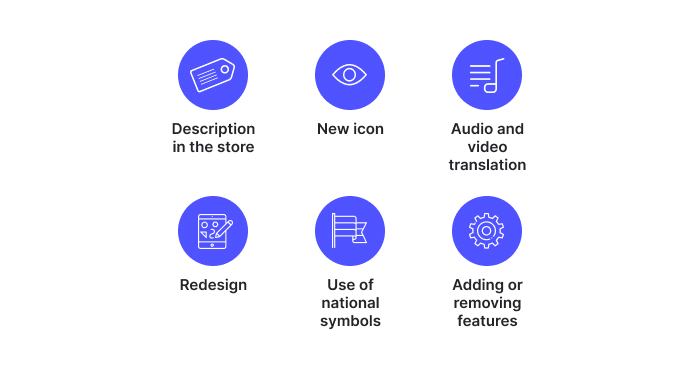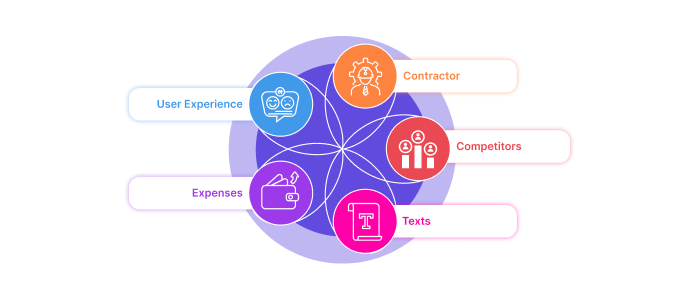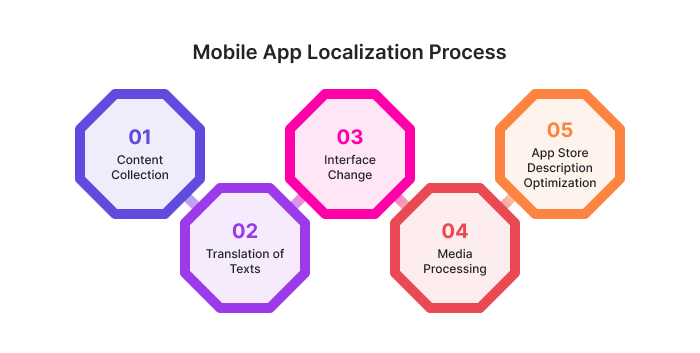 Mail
Mail
 Pocket
Pocket
Imagine that a useful app has been released in another country: you really needed such functions, and the interface looks stunning. But you are faced with a problem: the app is created in a language that you don’t understand. You choose your native language in the settings, but all the texts look like they were just put in an online translator and then returned to the app without any checks (or even left without translation).
If all app developers treated the mobile app localization with due attention, such situations would not be possible. And if the product is made with high quality, then users like it. Thus, it brings more money.
So, do you want your product to be successful in the international market? We have some advice.
Mobile app localization is the process of adapting a product to a new market and the language used there. This is not just a translation of all the texts of the app, but a wider range of tasks, which may include:

All this is done to ensure that the product functions more successfully in the new market and is accessible and understandable to new users.
Entering a new market is not always a clear and necessary goal, there must be something else behind it. However, you most likely have other needs that can be the base for app localization.
By translating a product into a new language, you immediately get thousands or even millions of potential customers. If you correctly build an advertising campaign and work on the quality of your app, then investments in localization will pay off several times over.
Being one of the best applications in the country is a pleasure. However, being an app like Facebook or Snapchat used all over the world is a much bigger achievement. Many businesses should compete to take such a worthy place among the global audience.
The more customers you get through localization, the more money you can earn. In addition, in the foreign market, you can optimize your pricing policy and adapt sales so that the app brings you even more money.
You don’t want to be left behind by apps like yours if they’ve already launched their products in other countries. On the one hand, you will have more competition, so it will be harder to win an audience. On the other hand, you will analyze the experience and mistakes of competitors and thus have a better chance of success.
Another option is when there are no analogues to your app on the market. Someday, someone will definitely do it… But why wait? If you have a product ready for international expansion, then you can quickly set up a localization workflow and launch it in a target country without having any competition at all.
To make localization effective, you need to prepare: get to know your audience better and adapt the app. Consider the following aspects of localization:

Keep the possibility of localization in mind at the stage of creating an app idea. However, even if you decide to localize the app just now, please note that texts in different languages can be of different lengths. You need to understand if you can optimize the interface so that everything looks good.
Calculate how much money you need to invest in localization. This is the work of professional translators, developers, designers, and even video editors, if you have such content in your app. Think about the work to begin with and consider all the costs.
Prepare the content you have. If you want to release an app in a global market really quickly, you will need only the main sections of the app. All texts must be submitted for translation in XML or XLIFF format: they contain all the strings of the app, so it will be easier to transfer content to a new version of the product.
Be sure to study the competitors’ apps: what do you like about their products? Why do customers choose them? In what style are the texts in their apps written? Choose the most successful solutions and come up with a unique selling proposition that will make your app stand out from the rest. According to buildfire, the Apple App Store alone has 1.96 million apps available for download, so you really should look for other similar apps and study them scrumptiously.
For localization, you need a reliable partner with experience in the targeted language. Look at examples of work, compare prices in different companies and read reviews about contractors. This will help you choose the best option: accurate localization at an affordable price.
Let’s say, you have prepared everything, and the last thing to do is to choose a contractor. You have several options: freelancers, in-house and outsource providers. Let’s describe each of them in detail and compare the pros and cons.
Freelancers are quite flexible and enthusiastic specialists. Moreover, they are not constrained by corporate frameworks and rules, so they can probably cope with the project quite quickly. In addition, the work of a freelancer doesn’t involve the cost of office rent or transportation, so the prices may be lower.
However, some freelancers are unreliable and may not be available when you need them. Besides, if you need to fix something or add some edits after the project is completed, you may not be able to reach your freelance contractor. You will have to look for a new specialist or cope on your own.
When you have your own team of translators working in your office, it’s convenient and reliable. They are well immersed in the project and know all the app’s features. Plus, you don’t have to worry about your employees wasting time and effort on another contractor. However, in this case, the cost of maintaining a specialist is higher, since they work for you full time. In addition, having gained enough experience, specialists may leave the company, and you will have to look for new translators.
An outsourcing company is a professional team of translators and other professionals who provide translation services for apps, texts, videos and more. These teams are usually highly qualified, while you don’t have to hire each specialist yourself and purchase equipment. Besides, outsource companies can provide styleguides, after-sales service, and even in-house IT-specialists to solve any technical issues within a project. Other advantages include:
The disadvantages depend on the specific company: some outsourcers approach clients using templates and don’t try to treat everyone individually. Others may offer prices so high that hiring in-house localizers would be even cheaper. Therefore, your important task is to study the market and choose a reliable contractor at favorable conditions.
How comfortable you will be working with any type of contractor depends on how carefully you choose them. Freelancers are an opportunity to save money, but at bigger risks; an in-house team will be reliable, but expensive; and outsourcers can be unreliable, but you can usually learn about the quality of a company from reviews.
Most likely, an outsourcing company will have the best price and high quality due to well-established localization processes. These people are not only involved in your projects, but they have working schemes for communication with clients, so you will be surrounded by attention and will be able to receive answers to questions and make changes in time.
So now you are ready to localize your app. Let’s look at the basic steps that are required for this.

Choose what exactly will be in the localized app. Perhaps you will start small and not translate all the content at once: only the main screens of the app that users need.
Now your contractor can start working with texts. These are regular texts and texts on videos or images. At this stage, it’s also important to localize the texts for a new audience: correctly translate the format of the date, measurements, and even emojis.
Some texts may be too short or too long for the design you already have. Edit all screens that look incorrect so that the user interface is convenient and beautiful.
In addition to the localization itself, you need to take into account the obstacles that may stand in your way. Undoubtedly, it’s almost impossible to predict all the potential circumstances. However, many mobile product creators face common difficulties.
Think about which countries you want to reach and how to make sure that the product can be optimized for them. Leave space between UI elements, study the cultural characteristics of different countries and think about how your app will be suitable for use there.
Translation and interface are things that can be done quickly and easily. But only if you need a low quality product. Have you seen store descriptions translated from Chinese using an online translator? This is definitely not something that causes confidence and desire to download a product. According to data.ai, modern users spend about 4.8 hours per day on mobile apps, so they need convenient and catchy products.
Always keep the culture of your potential customers in mind. When translating, don’t use jokes, images or other elements that may offend or anger representatives of other nations and religions. To do this, you need to carefully study the cultural characteristics and work with localization professionals.
You may be surprised, but app localization sometimes takes much longer than you’d like. For example, if there are a lot of graphic elements or complex terms. Allocate enough time for localization so as not to hurry and disappoint customers.
Professional localizers use software that allows you to save text fragments and reuse them, as well as take translations from a verified database. Don’t try to translate texts and keep documentation in some kind of spreadsheet on your own: this will reduce the quality of the translation and cause countless errors.
Palex company has broad experience in the localization of mobile products: for example, complex multilanguage and engineering solutions for the Brother company. We work with 80+ languages and use the latest translation technologies. More than 70 partners in 39 countries trust us with their projects, and you can become one of them. Drop us a line at [email protected]. Let’s start working together on the localization of your mobile app right now!




